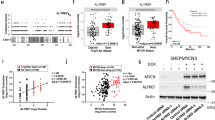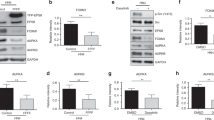Abstract
The ERK group of mitogen-activated protein kinases (MAPKs) is essential for cell proliferation stimulated by mitogens, oncogenic ras and raf (ref. 1). All MAPKs are activated by MAP3K/MEK/MAPK core pathways1 and the Raf proto-oncoproteins, especially B-Raf, are ERK-specific MAP3Ks (refs 1–3). Mixed lineage kinase-3 (MLK3) is a MAP3K that was thought to be a cytokine-activated, and comparatively selective, regulator of the JNK group of MAPKs (refs 1, 4–6). Here we report that silencing of mlk3 by RNAi suppressed mitogen and cytokine activation not only of JNK but of ERK and p38 as well. Silencing mlk3 also blocked mitogen-stimulated phosphorylation of B-Raf at Thr 598 and Ser 601, a step required for B-Raf activation7,8. Furthermore, silencing mlk3 prevented serum-stimulated cell proliferation and the proliferation of tumour cells bearing either oncogenic Ki-Ras or loss-of-function neurofibromatosis-1 (NF1) or NF2 mutations. The proliferation of tumour cells containing activating B-raf or raf-1 mutations was unaffected by silencing mlk3. Our results define an unexpected role for MLK3 in mitogen regulation of B-Raf, ERK and cell proliferation.
This is a preview of subscription content, access via your institution
Access options
Subscribe to this journal
Receive 12 print issues and online access
$209.00 per year
only $17.42 per issue
Buy this article
- Purchase on Springer Link
- Instant access to full article PDF
Prices may be subject to local taxes which are calculated during checkout




Similar content being viewed by others
References
Kyriakis, J.M. in Protein Kinase Functions (ed. Woodgett, J.R.) 40–156 (Oxford University Press, Oxford, 2000).
Wojnowski, L. et al. Endothelial apoptosis in Braf-deficient mice. Nature Genet. 16, 293–297 (1997).
Wojnowski, L. et al. Overlapping and specific functions of Braf and Craf-1 proto-oncogenes during mouse embryogenesis. Mech. Dev. 91, 97–104 (2000).
Gallo, K.A. & Johnson, G.L. Mixed-lineage kinase control of JNK and p38 MAPK pathways. Nature Rev. Mol. Cell. Biol. 3, 663–672 (2002).
Sathyanarayana, P. et al. Activation of the Drosophila MLK by ceramide reveals TNF-α and ceramide as agonists of mammalian MLK3. Mol. Cell 10, 1527–1533 (2002).
Shen, Y.H. et al. Cross-talk between JNK/SAPK and ERK/MAPK pathways: sustained activation of JNK blocks ERK activation by mitogenic factors. J. Biol. Chem. 278, 26715–26721 (2003).
Zhang, B.-H. & Guan, K.-L. Activation of B-Raf kinase requires phosphorylation of the conserved residues Thr598 and Ser601. EMBO J. 19, 5429–5439 (2000).
Chong, H., Lee, J. & Guan, K.-L. Positive and negative regulation of Raf kinase activity and function by phosphorylation. EMBO J. 20, 3716–3727 (2001).
Davies, H. et al. Mutations of the BRAF gene in human cancer. Nature 417, 949–954 (2002).
Malumbres, M. & Barbacid, M. RAS oncogenes: the first 30 years. Nature Rev. Cancer 3, 459–465 (2003).
McCormick, F. Activators and effectors of ras p21 proteins. Curr. Opin. Genet. Dev. 4, 71–76 (1994).
Marshall, C.J. Ras effectors. Curr. Opin. Cell Biol. 8, 197–204 (1996).
Downward, J. Targeting RAS signalling pathways in cancer therapy. Nature Rev. Cancer. 3, 11–22 (2003).
Cichowski, K. & Jacks, T. NF1 tumor suppressor gene function: narrowing the GAP. Cell 104, 593–604 (2001).
Lynch, T.M. & Gutmann, D.H. Neurofibromatosis 1. 20, 841–865 (2002).
Elbashir, S.M. et al. Duplexes of 21-nucleotide RNAs mediate RNA interference in cultured mammalian cells. Nature 411, 494–498 (2001).
Chi, J.T. et al. Genomewide view of gene silencing by small interfering RNAs. Proc. Natl Acad. Sci. USA. 100, 6343–6346 (2003).
Semizarov, D. et al. Specificity of short interfering RNA determined through gene expression signatures. Proc. Natl Acad. Sci. USA. 100, 6347–6352 (2003).
Kyriakis, J.M. et al. The stress-activated protein kinase subfamily of c-Jun kinases. Nature 369, 156–160 (1994).
Dumitru, C.D. et al. TNF-α induction by LPS is regulated posttranscriptionally via a Tpl-2/ERK-dependent pathway. Cell 103, 1071–1083 (2000).
Sledz, C.A., Holko, M., de Veer, M.J., Silverman, R.H. & Williams, B.R.G. Activation of the interferon system by short-interfering RNAs. Nature Cell Biol. 5, 834–839 (2003).
Wan, P.T.C. et al. Mechanism of activation of the Raf-ERK signaling pathway by oncogenic mutations of B-RAF. Cell 116, 855–867 (2004).
Mercer, K.E. & Pritchard, C.A. Raf proteins and cancer: B-Raf is identified as a mutational target. Biochim. Biophys. Acta 1653, 25–40 (2003).
Mansour, S.J. et al. Transformation of mammalian cells by constitutively active MAP kinase kinase. Science 265, 966–970 (1994).
Lavoie, J.N., L'Allemain, G., Brunet, A., Müller, R. & Pouysségur, J. Cyclin D1 expression is regulated positively by the p42/p44 MAPK and negatively by the p38/HOG MAPK pathway. J. Biol. Chem. 271, 20608–20616 (1996).
Brunet, A. et al. Nuclear translocation of p42/p44 mitogen-activated protein kinase is required for growth factor-induced gene expression and cell cycle entry. EMBO J. 18, 664–674 (1999).
Balmanno, K. & Cook, S.J. Sustained MAP kinase activation is required for the expression of cyclin D1, p21 Cip1 and a subset of AP-1 proteins in CCL39 cells. Oncogene 18, 3085–3097 (1999).
Swenson, K.I., Winkler, K.E. & Means, A.R. A new identity for MLK3 as a NIMA-related, cell cycle-regulated kinase that is localized near centrosomes and influences microtubule organization. Mol. Biol. Cell 14, 156–172 (2003).
Sherr, C.J. The Pezcoller lecture: cancer cell cycles revisited. Cancer Res. 60, 3689–3695 (2000).
McClatchey, A.I. Merlin and ERM proteins: unappreciated roles in cancer development? Nature Rev. Cancer 3, 877–883 (2003).
Acknowledgements
We thank J. Avruch and N. Birnberg for MEK1 cDNA and discussions; A. McLatchey for F3439 cells; A. Guha and J. Fletcher for ST88-14 cells; Q.P. Weng and N. Birnberg for Ki-ras-transformed NIH3T3 cells; A. Agarwal and A. Kuliopulos for SKOV3 cells; R. Gerszten for HUVECs; and M. Comb for anti-p-Thr598/Ser601-B-Raf antibody. This work was supported by grants from the US National Institute of General Medical Sciences and the Arthritis Foundation (to J.M.K.) and the American Heart Association, Massachusetts Chapter (to D.N.C.).
Author information
Authors and Affiliations
Corresponding author
Ethics declarations
Competing interests
The authors declare no competing financial interests.
Supplementary information
Rights and permissions
About this article
Cite this article
Chadee, D., Kyriakis, J. MLK3 is required for mitogen activation of B-Raf, ERK and cell proliferation. Nat Cell Biol 6, 770–776 (2004). https://doi.org/10.1038/ncb1152
Received:
Accepted:
Published:
Issue Date:
DOI: https://doi.org/10.1038/ncb1152
This article is cited by
-
MLK4 promotes glucose metabolism in lung adenocarcinoma through CREB-mediated activation of phosphoenolpyruvate carboxykinase and is regulated by KLF5
Oncogenesis (2023)
-
MLK3 localizes mainly to the cytoplasm and promotes oxidative stress injury via a positive feedback loop
Cell Biochemistry and Biophysics (2023)
-
HSP90-CDC37-PP5 forms a structural platform for kinase dephosphorylation
Nature Communications (2022)
-
Synergism between the phosphatidylinositol 3-kinase p110β isoform inhibitor AZD6482 and the mixed lineage kinase 3 inhibitor URMC-099 on the blockade of glioblastoma cell motility and focal adhesion formation
Cancer Cell International (2021)
-
Expression of FGD4 positively correlates with the aggressive phenotype of prostate cancer
BMC Cancer (2018)




